ignition GMC SAVANA 2008 Owner's Manual
[x] Cancel search | Manufacturer: GMC, Model Year: 2008, Model line: SAVANA, Model: GMC SAVANA 2008Pages: 402, PDF Size: 2.45 MB
Page 71 of 402
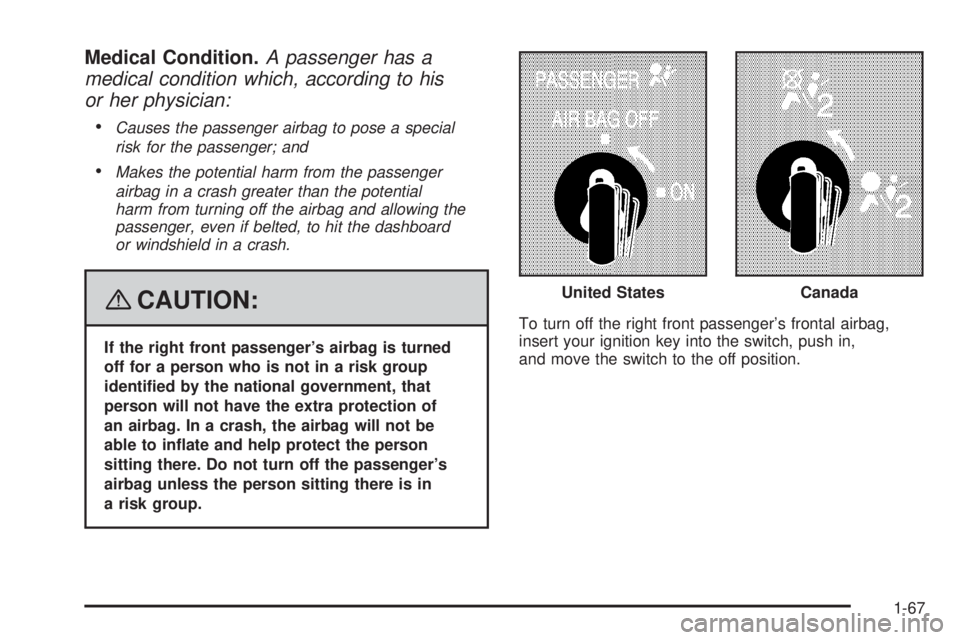
Medical Condition.A passenger has a
medical condition which, according to his
or her physician:
•
Causes the passenger airbag to pose a special
risk for the passenger; and
•Makes the potential harm from the passenger
airbag in a crash greater than the potential
harm from turning off the airbag and allowing the
passenger, even if belted, to hit the dashboard
or windshield in a crash.
{CAUTION:
If the right front passenger’s airbag is turned
off for a person who is not in a risk group
identi�ed by the national government, that
person will not have the extra protection of
an airbag. In a crash, the airbag will not be
able to in�ate and help protect the person
sitting there. Do not turn off the passenger’s
airbag unless the person sitting there is in
a risk group.To turn off the right front passenger’s frontal airbag,
insert your ignition key into the switch, push in,
and move the switch to the off position.United States
Canada
1-67
Page 72 of 402
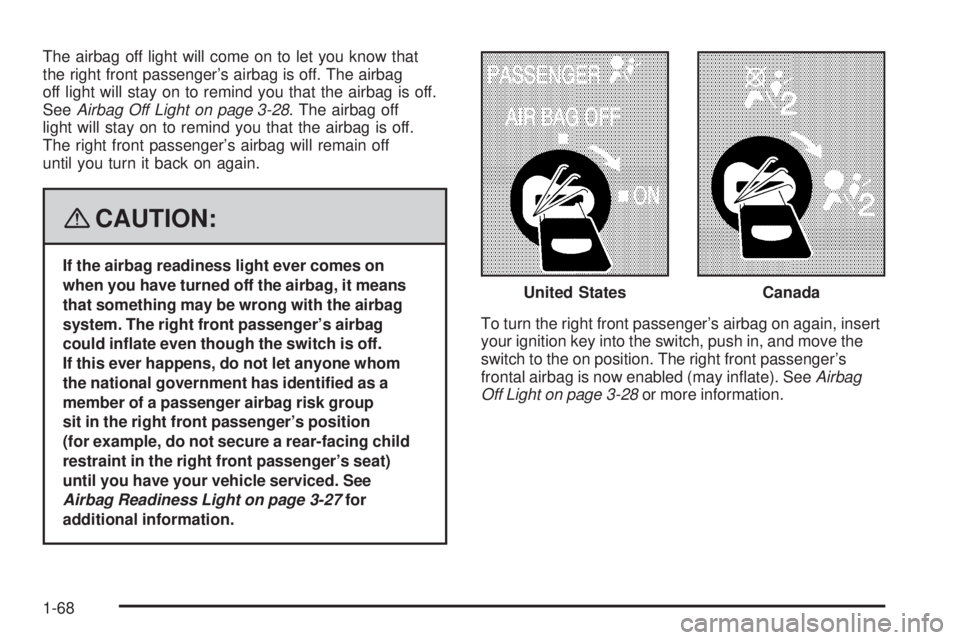
The airbag off light will come on to let you know that
the right front passenger’s airbag is off. The airbag
off light will stay on to remind you that the airbag is off.
SeeAirbag Off Light on page 3-28. The airbag off
light will stay on to remind you that the airbag is off.
The right front passenger’s airbag will remain off
until you turn it back on again.
{CAUTION:
If the airbag readiness light ever comes on
when you have turned off the airbag, it means
that something may be wrong with the airbag
system. The right front passenger’s airbag
could in�ate even though the switch is off.
If this ever happens, do not let anyone whom
the national government has identi�ed as a
member of a passenger airbag risk group
sit in the right front passenger’s position
(for example, do not secure a rear-facing child
restraint in the right front passenger’s seat)
until you have your vehicle serviced. See
Airbag Readiness Light on page 3-27for
additional information.To turn the right front passenger’s airbag on again, insert
your ignition key into the switch, push in, and move the
switch to the on position. The right front passenger’s
frontal airbag is now enabled (may inflate). SeeAirbag
Off Light on page 3-28or more information. United States
Canada
1-68
Page 77 of 402
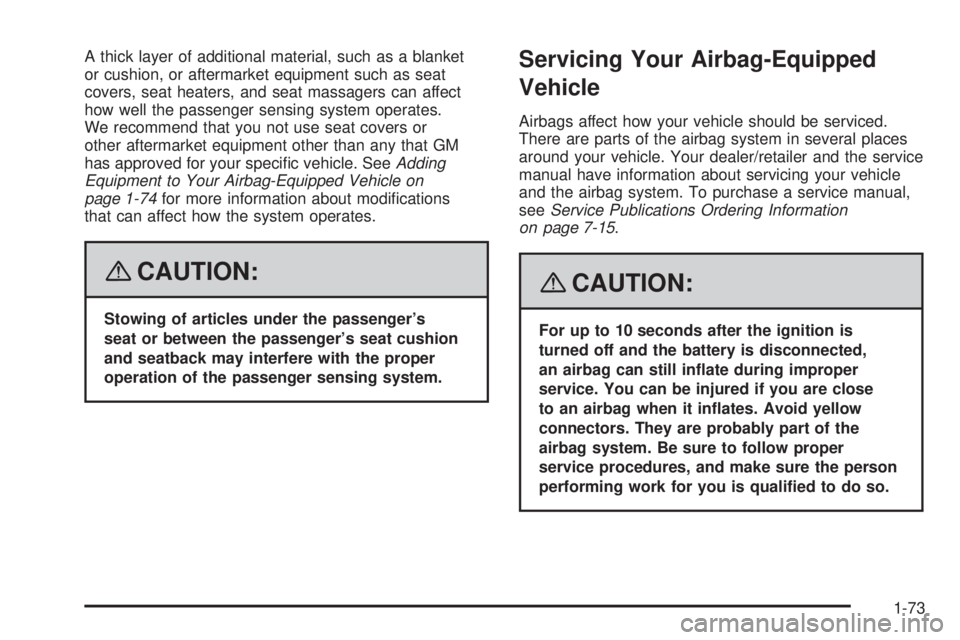
A thick layer of additional material, such as a blanket
or cushion, or aftermarket equipment such as seat
covers, seat heaters, and seat massagers can affect
how well the passenger sensing system operates.
We recommend that you not use seat covers or
other aftermarket equipment other than any that GM
has approved for your specific vehicle. SeeAdding
Equipment to Your Airbag-Equipped Vehicle on
page 1-74for more information about modifications
that can affect how the system operates.
{CAUTION:
Stowing of articles under the passenger’s
seat or between the passenger’s seat cushion
and seatback may interfere with the proper
operation of the passenger sensing system.
Servicing Your Airbag-Equipped
Vehicle
Airbags affect how your vehicle should be serviced.
There are parts of the airbag system in several places
around your vehicle. Your dealer/retailer and the service
manual have information about servicing your vehicle
and the airbag system. To purchase a service manual,
seeService Publications Ordering Information
on page 7-15.
{CAUTION:
For up to 10 seconds after the ignition is
turned off and the battery is disconnected,
an airbag can still in�ate during improper
service. You can be injured if you are close
to an airbag when it in�ates. Avoid yellow
connectors. They are probably part of the
airbag system. Be sure to follow proper
service procedures, and make sure the person
performing work for you is quali�ed to do so.
1-73
Page 81 of 402
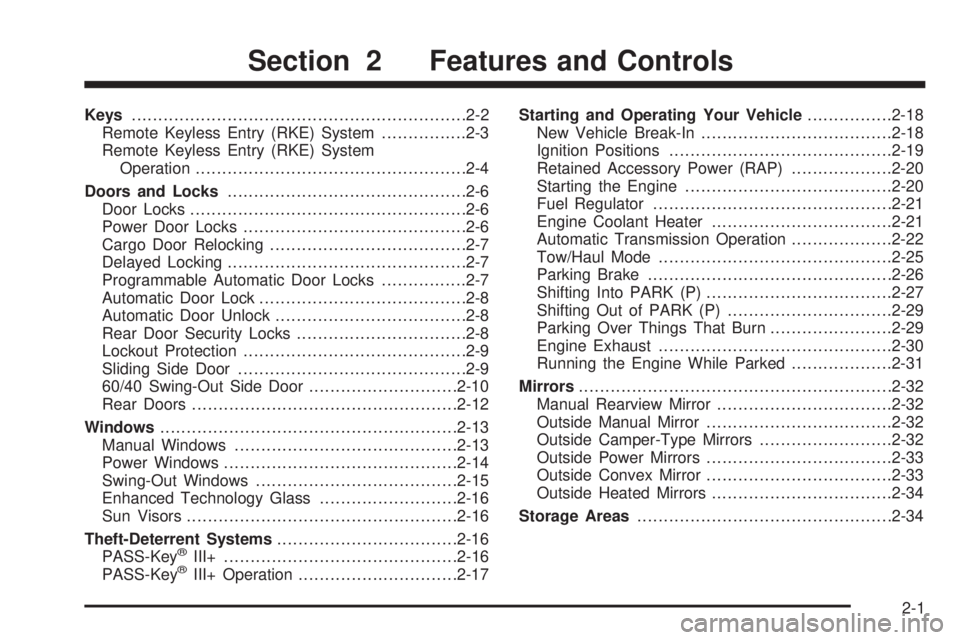
Keys...............................................................2-2
Remote Keyless Entry (RKE) System................2-3
Remote Keyless Entry (RKE) System
Operation...................................................2-4
Doors and Locks.............................................2-6
Door Locks....................................................2-6
Power Door Locks..........................................2-6
Cargo Door Relocking.....................................2-7
Delayed Locking.............................................2-7
Programmable Automatic Door Locks................2-7
Automatic Door Lock.......................................2-8
Automatic Door Unlock....................................2-8
Rear Door Security Locks................................2-8
Lockout Protection..........................................2-9
Sliding Side Door...........................................2-9
60/40 Swing-Out Side Door............................2-10
Rear Doors..................................................2-12
Windows........................................................2-13
Manual Windows..........................................2-13
Power Windows............................................2-14
Swing-Out Windows......................................2-15
Enhanced Technology Glass..........................2-16
Sun Visors...................................................2-16
Theft-Deterrent Systems..................................2-16
PASS-Key
®III+............................................2-16
PASS-Key®III+ Operation..............................2-17Starting and Operating Your Vehicle................2-18
New Vehicle Break-In....................................2-18
Ignition Positions..........................................2-19
Retained Accessory Power (RAP)...................2-20
Starting the Engine.......................................2-20
Fuel Regulator.............................................2-21
Engine Coolant Heater..................................2-21
Automatic Transmission Operation...................2-22
Tow/Haul Mode............................................2-25
Parking Brake..............................................2-26
Shifting Into PARK (P)...................................2-27
Shifting Out of PARK (P)...............................2-29
Parking Over Things That Burn.......................2-29
Engine Exhaust............................................2-30
Running the Engine While Parked...................2-31
Mirrors...........................................................2-32
Manual Rearview Mirror.................................2-32
Outside Manual Mirror...................................2-32
Outside Camper-Type Mirrors.........................2-32
Outside Power Mirrors...................................2-33
Outside Convex Mirror...................................2-33
Outside Heated Mirrors..................................2-34
Storage Areas................................................2-34
Section 2 Features and Controls
2-1
Page 82 of 402
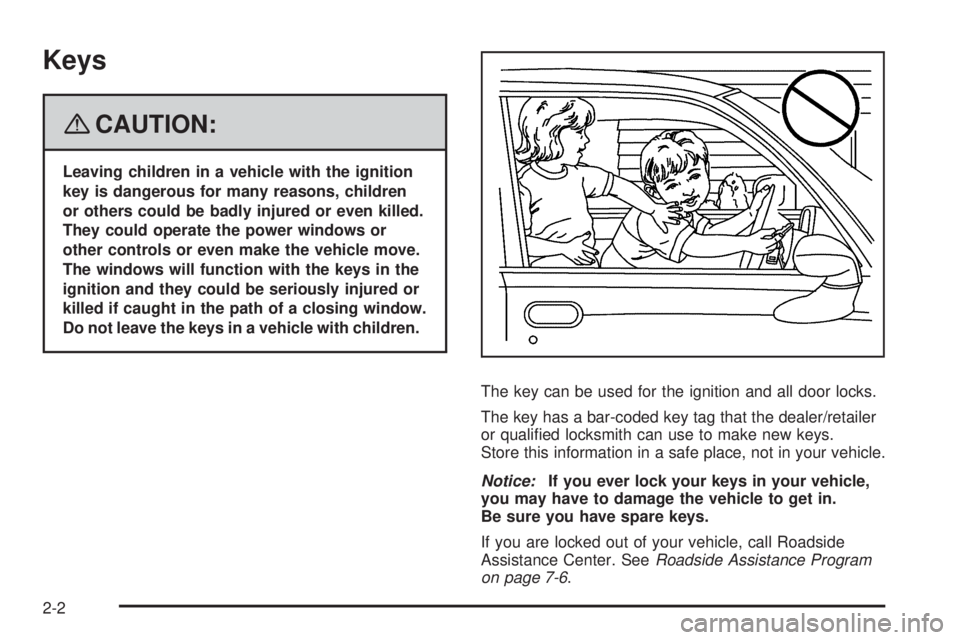
Keys
{CAUTION:
Leaving children in a vehicle with the ignition
key is dangerous for many reasons, children
or others could be badly injured or even killed.
They could operate the power windows or
other controls or even make the vehicle move.
The windows will function with the keys in the
ignition and they could be seriously injured or
killed if caught in the path of a closing window.
Do not leave the keys in a vehicle with children.
The key can be used for the ignition and all door locks.
The key has a bar-coded key tag that the dealer/retailer
or qualified locksmith can use to make new keys.
Store this information in a safe place, not in your vehicle.
Notice:If you ever lock your keys in your vehicle,
you may have to damage the vehicle to get in.
Be sure you have spare keys.
If you are locked out of your vehicle, call Roadside
Assistance Center. SeeRoadside Assistance Program
on page 7-6.
2-2
Page 84 of 402
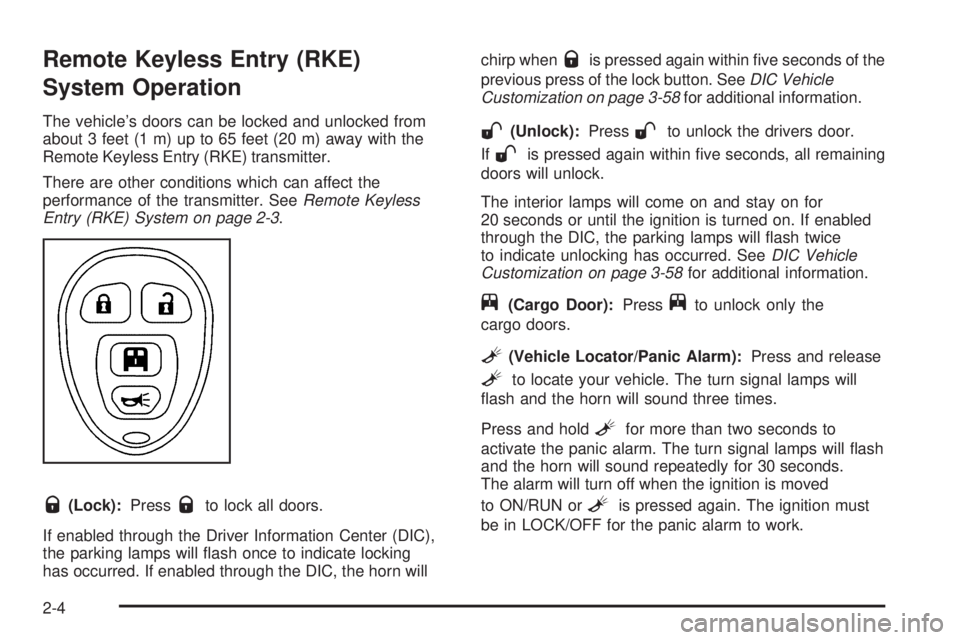
Remote Keyless Entry (RKE)
System Operation
The vehicle’s doors can be locked and unlocked from
about 3 feet (1 m) up to 65 feet (20 m) away with the
Remote Keyless Entry (RKE) transmitter.
There are other conditions which can affect the
performance of the transmitter. SeeRemote Keyless
Entry (RKE) System on page 2-3.
Q(Lock):PressQto lock all doors.
If enabled through the Driver Information Center (DIC),
the parking lamps will flash once to indicate locking
has occurred. If enabled through the DIC, the horn willchirp when
Qis pressed again within five seconds of the
previous press of the lock button. SeeDIC Vehicle
Customization on page 3-58for additional information.
W(Unlock):PressWto unlock the drivers door.
If
Wis pressed again within five seconds, all remaining
doors will unlock.
The interior lamps will come on and stay on for
20 seconds or until the ignition is turned on. If enabled
through the DIC, the parking lamps will flash twice
to indicate unlocking has occurred. SeeDIC Vehicle
Customization on page 3-58for additional information.
j(Cargo Door):Pressjto unlock only the
cargo doors.
L(Vehicle Locator/Panic Alarm):Press and release
Lto locate your vehicle. The turn signal lamps will
flash and the horn will sound three times.
Press and hold
Lfor more than two seconds to
activate the panic alarm. The turn signal lamps will flash
and the horn will sound repeatedly for 30 seconds.
The alarm will turn off when the ignition is moved
to ON/RUN or
Lis pressed again. The ignition must
be in LOCK/OFF for the panic alarm to work.
2-4
Page 87 of 402
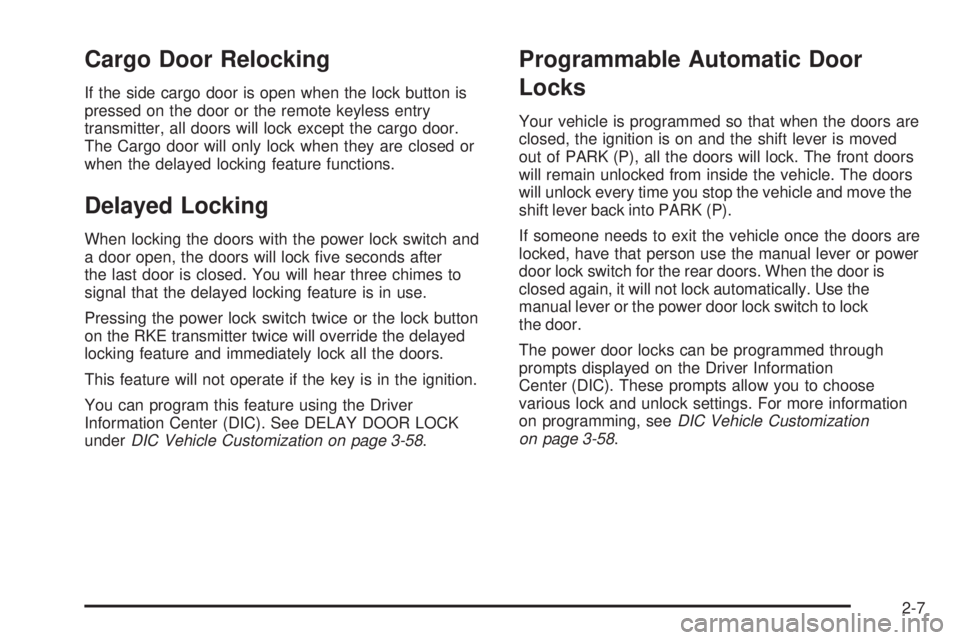
Cargo Door Relocking
If the side cargo door is open when the lock button is
pressed on the door or the remote keyless entry
transmitter, all doors will lock except the cargo door.
The Cargo door will only lock when they are closed or
when the delayed locking feature functions.
Delayed Locking
When locking the doors with the power lock switch and
a door open, the doors will lock five seconds after
the last door is closed. You will hear three chimes to
signal that the delayed locking feature is in use.
Pressing the power lock switch twice or the lock button
on the RKE transmitter twice will override the delayed
locking feature and immediately lock all the doors.
This feature will not operate if the key is in the ignition.
You can program this feature using the Driver
Information Center (DIC). See DELAY DOOR LOCK
underDIC Vehicle Customization on page 3-58.
Programmable Automatic Door
Locks
Your vehicle is programmed so that when the doors are
closed, the ignition is on and the shift lever is moved
out of PARK (P), all the doors will lock. The front doors
will remain unlocked from inside the vehicle. The doors
will unlock every time you stop the vehicle and move the
shift lever back into PARK (P).
If someone needs to exit the vehicle once the doors are
locked, have that person use the manual lever or power
door lock switch for the rear doors. When the door is
closed again, it will not lock automatically. Use the
manual lever or the power door lock switch to lock
the door.
The power door locks can be programmed through
prompts displayed on the Driver Information
Center (DIC). These prompts allow you to choose
various lock and unlock settings. For more information
on programming, seeDIC Vehicle Customization
on page 3-58.
2-7
Page 89 of 402
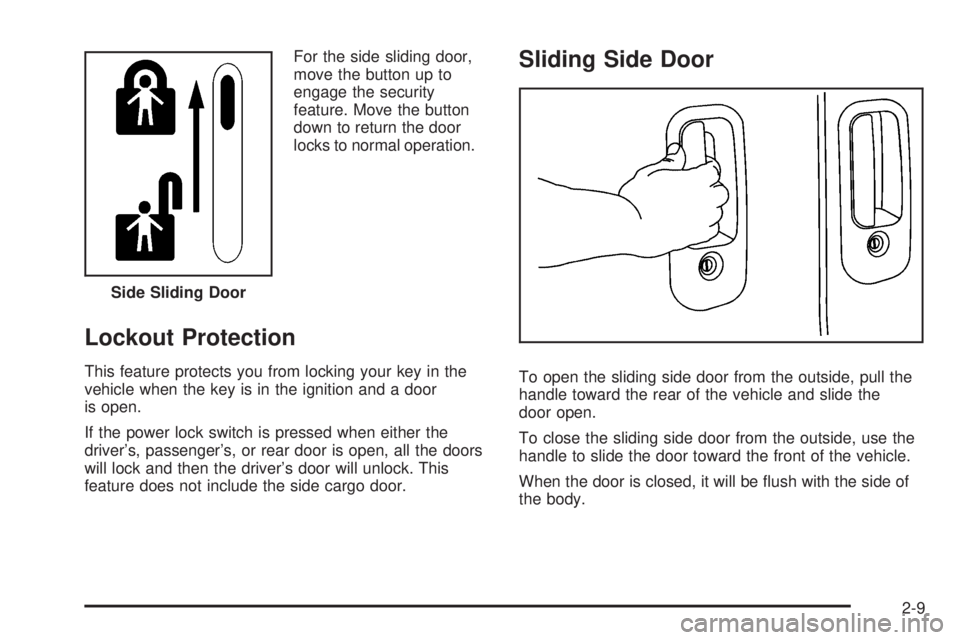
For the side sliding door,
move the button up to
engage the security
feature. Move the button
down to return the door
locks to normal operation.
Lockout Protection
This feature protects you from locking your key in the
vehicle when the key is in the ignition and a door
is open.
If the power lock switch is pressed when either the
driver’s, passenger’s, or rear door is open, all the doors
will lock and then the driver’s door will unlock. This
feature does not include the side cargo door.
Sliding Side Door
To open the sliding side door from the outside, pull the
handle toward the rear of the vehicle and slide the
door open.
To close the sliding side door from the outside, use the
handle to slide the door toward the front of the vehicle.
When the door is closed, it will be flush with the side of
the body. Side Sliding Door
2-9
Page 94 of 402
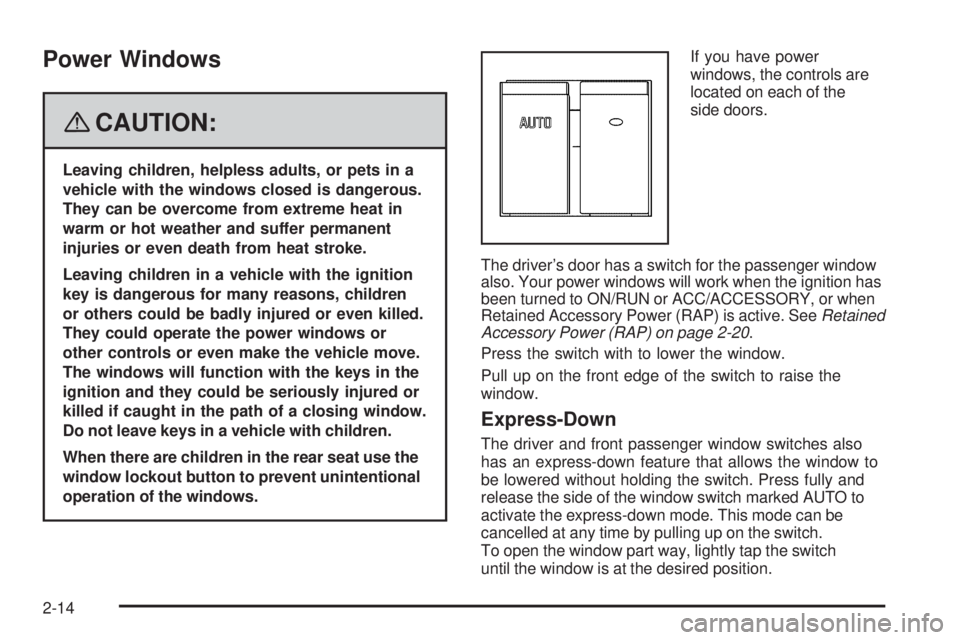
Power Windows
{CAUTION:
Leaving children, helpless adults, or pets in a
vehicle with the windows closed is dangerous.
They can be overcome from extreme heat in
warm or hot weather and suffer permanent
injuries or even death from heat stroke.
Leaving children in a vehicle with the ignition
key is dangerous for many reasons, children
or others could be badly injured or even killed.
They could operate the power windows or
other controls or even make the vehicle move.
The windows will function with the keys in the
ignition and they could be seriously injured or
killed if caught in the path of a closing window.
Do not leave keys in a vehicle with children.
When there are children in the rear seat use the
window lockout button to prevent unintentional
operation of the windows.If you have power
windows, the controls are
located on each of the
side doors.
The driver’s door has a switch for the passenger window
also. Your power windows will work when the ignition has
been turned to ON/RUN or ACC/ACCESSORY, or when
Retained Accessory Power (RAP) is active. SeeRetained
Accessory Power (RAP) on page 2-20.
Press the switch with to lower the window.
Pull up on the front edge of the switch to raise the
window.
Express-Down
The driver and front passenger window switches also
has an express-down feature that allows the window to
be lowered without holding the switch. Press fully and
release the side of the window switch marked AUTO to
activate the express-down mode. This mode can be
cancelled at any time by pulling up on the switch.
To open the window part way, lightly tap the switch
until the window is at the desired position.
2-14
Page 97 of 402
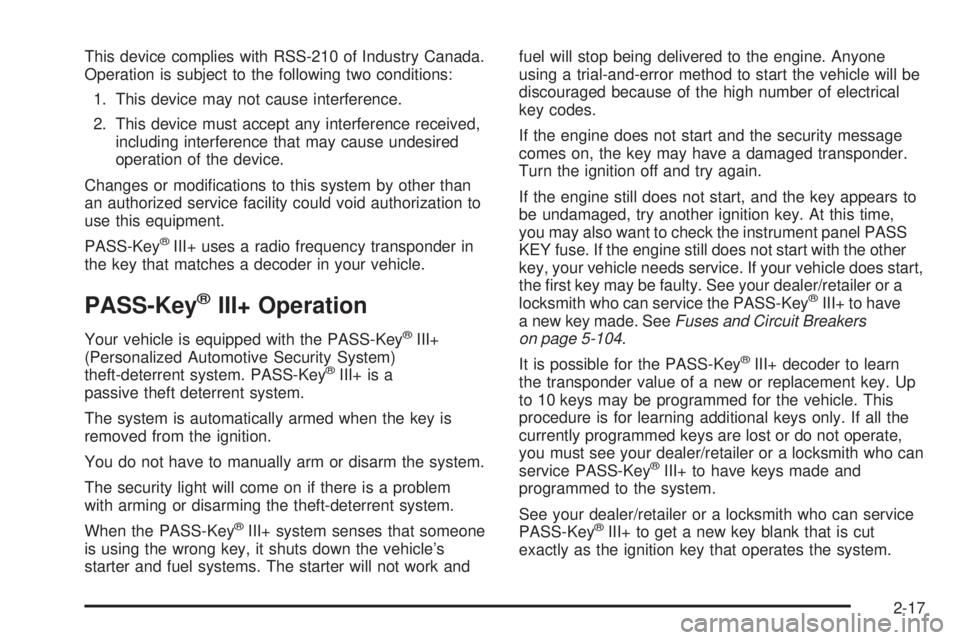
This device complies with RSS-210 of Industry Canada.
Operation is subject to the following two conditions:
1. This device may not cause interference.
2. This device must accept any interference received,
including interference that may cause undesired
operation of the device.
Changes or modifications to this system by other than
an authorized service facility could void authorization to
use this equipment.
PASS-Key
®III+ uses a radio frequency transponder in
the key that matches a decoder in your vehicle.
PASS-Key®III+ Operation
Your vehicle is equipped with the PASS-Key®III+
(Personalized Automotive Security System)
theft-deterrent system. PASS-Key
®III+ is a
passive theft deterrent system.
The system is automatically armed when the key is
removed from the ignition.
You do not have to manually arm or disarm the system.
The security light will come on if there is a problem
with arming or disarming the theft-deterrent system.
When the PASS-Key
®III+ system senses that someone
is using the wrong key, it shuts down the vehicle’s
starter and fuel systems. The starter will not work andfuel will stop being delivered to the engine. Anyone
using a trial-and-error method to start the vehicle will be
discouraged because of the high number of electrical
key codes.
If the engine does not start and the security message
comes on, the key may have a damaged transponder.
Turn the ignition off and try again.
If the engine still does not start, and the key appears to
be undamaged, try another ignition key. At this time,
you may also want to check the instrument panel PASS
KEY fuse. If the engine still does not start with the other
key, your vehicle needs service. If your vehicle does start,
the first key may be faulty. See your dealer/retailer or a
locksmith who can service the PASS-Key
®III+ to have
a new key made. SeeFuses and Circuit Breakers
on page 5-104.
It is possible for the PASS-Key
®III+ decoder to learn
the transponder value of a new or replacement key. Up
to 10 keys may be programmed for the vehicle. This
procedure is for learning additional keys only. If all the
currently programmed keys are lost or do not operate,
you must see your dealer/retailer or a locksmith who can
service PASS-Key
®III+ to have keys made and
programmed to the system.
See your dealer/retailer or a locksmith who can service
PASS-Key
®III+ to get a new key blank that is cut
exactly as the ignition key that operates the system.
2-17